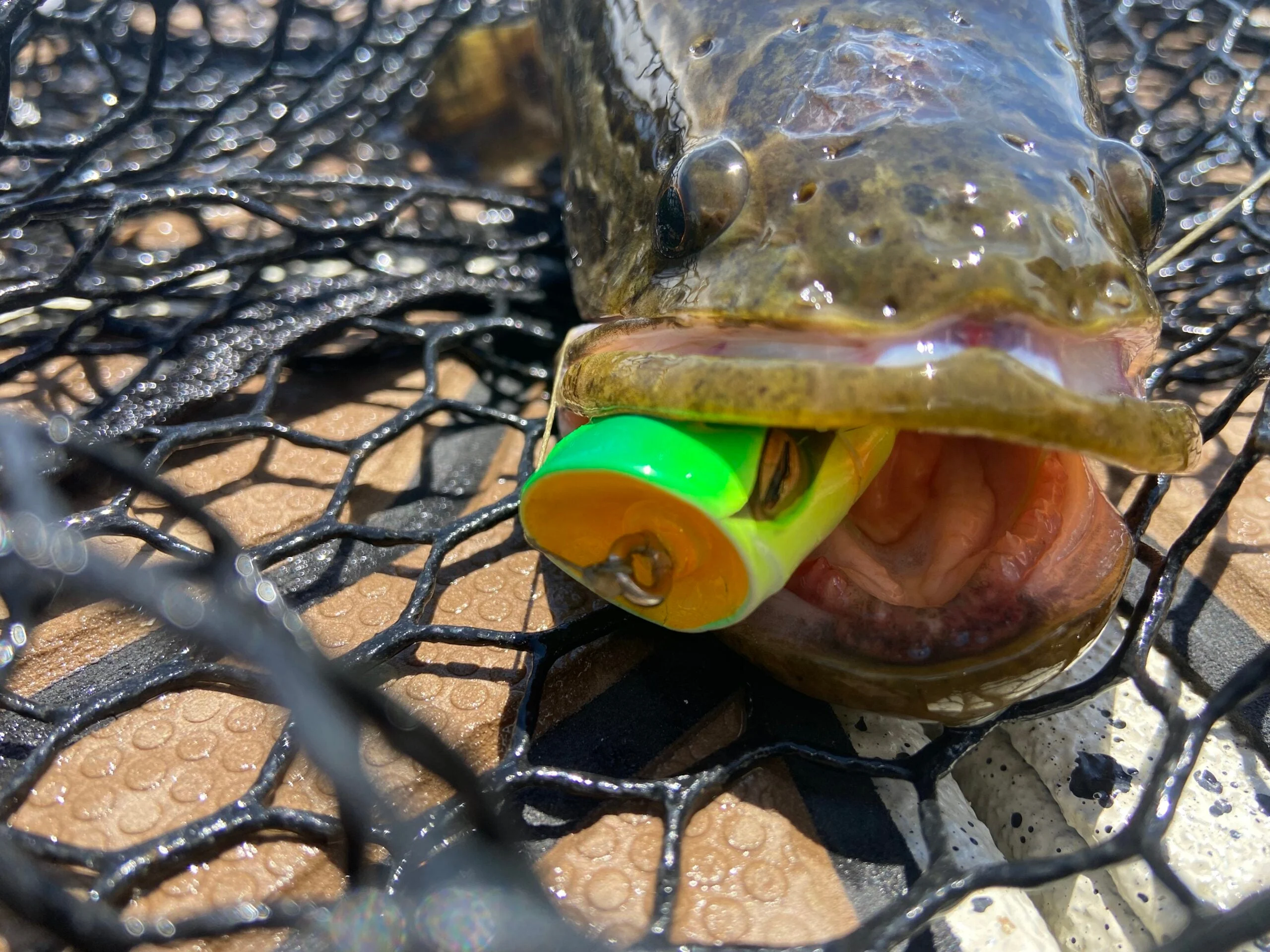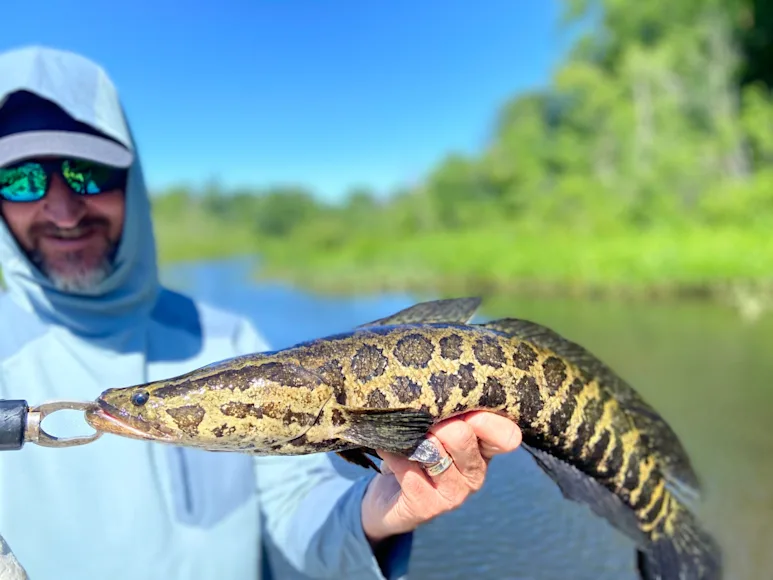is a negative word. It refers to the unwanted, the obtrusive, and the undesirable. It’s fitting, no doubt, when talking about plants, animals, and fish that aren’t native to the U.S., especially considering that invasive things tend to disrupt the natural order and sometimes cause harm to the ecosystem. The thing is, the invasive label also tends to cloud our abilities to find any good or any benefit to the culprits, and this is particularly true with species of invasive fish
.
With all the fish covered here, it is very unlikely that we will ever see them completely eradicated from our waters, as some have had 40 years to establish a presence. None of them should be here, and we’d be much better off without them. But they are here, so it makes little sense to refuse to explore the fun, challenges, and delicious meals that come from chasing them simply because we’re told they’re bad. If you’ve got an open mind or want to do your part to rid the U.S. of these invaders, here are the five species of invasive fish that will give you the biggest adrenaline rushes—whether you prefer to fire a fly rod
, cast topwater lures
, go bowfishing
, or spearfishing
.
1. Snakehead: The Topwater Terror

Snakeheads are suckers for topwater lures. Joe Cermele
Native Range: Indonesia, Southeast Asia, India, Southeastern Russia.
How Snakeheads Got Here
Though there are dozens of snakehead
species living across their native ranges overseas, to date only two have gained strongholds in the United States—the northern snakehead and the bullseye snakehead. The northern snakehead is the most common, as well as the most tolerant of seasonal temperature swings, which has allowed its population to explode from Central Virginia through the lower Southern Tier of New York state. Isolated reports, however, range as far north as Massachusetts and as far south as Georgia.
The bullseye snakehead, conversely, is less tolerant of cold swings, which has helped to keep its population contained in South Florida, roughly from Miami to West Palm Beach. Both species were first discovered in the early 2000s, creating media firestorms. Juvenile snakeheads have long been popular aquarium fish, as well as a popular food fish among Asian cultures. These demands eventually led to illegal releases in public waters where the species flourished.
How to Catch Snakeheads
If you’re the kind of person that looks for silver linings in tough situations, the arrival of snakehead has a big one for anglers. They are most easily and successfully targeted on the surface, and when they take down a topwater lure, it’s one heck of a rush. Then, once you set that hook, these fish go absolutely nuts. If you’re addicted to sight-fishing, you’d be hard pressed to find a more challenging and exciting target in freshwater.
Read Next: Why Snakeheads Are Better Than Bass
Northern and bullseye snakeheads behave almost identically. They gravitate to shallow areas chocked full of weeds and vegetation. If it looks too thick for any fish to live in, that’s where you’ll find snakeheads. They do, however, need deep water as well, so weedy flats, coves, and creeks near drop-offs or channels are excellent locations to begin a quest. In the canal systems of South Florida, you’ll often find active feeders in the vegetation right on the very edges of the canals; in the north, areas with a combination of lily pads, milfoil, and hydrilla are prime.
Though it is possible to fool these fish on subsurface lures when you find them in deeper or more open water, nothing beats a hollow-body frog lures
, as they are designed to work through the nastiest surface vegetation without getting snagged or covered with debris. As you work a frog, keep an eye out for boils behind it or the approaching wake of a snakehead in pursuit. When it happens, pause so the fish can catch up, then gently move the frog to (hopefully) prompt a toilet-flush take. Make sure you’re using heavy tackle and at least 30-pound braided fishing line
so you can really drive in those hooks and muscle the fish to the net.
Can You Eat Snakehead Fish?
The media frenzy around snakeheads has caused a lot of non-fisherfolk to regard them as hideous, disgusting monsters. Given that they thrive in shallow, muddy areas, the idea of eating one turns off most of the uninitiated. The truth is, snakeheads are one of the cleanest, best-tasting fish in freshwater, with a texture more akin to saltwater snapper.
2. Clown Knifefish: The Backwards Brawlers

Angler Ryan Lily shows off a clown knifefish. Old Town
Native Range: Southeast Asia
How Clown Knifefish Got Here
Clown Knifefish have been here for much longer than snakeheads. The state of Florida got their first reports of them from Palm Beach and Broward Counties in the 1990s and linked them—like many other invasive species in Florida—to the aquarium trade.
With silver triangular bodies and vivid spots, juvenile clown knifefish were unique additions to fish tanks. The problem was that they’re carnivorous and required live food, and they can grow up to 3 feet long. Once these sleek fish outgrew their tanks, into local waterways they went.
The saving grace has been their extremely low tolerance for cold conditions. In fact, Florida claimed the abnormally low temperatures during the winter of 2010-2011 obliterated the wild clown knifefish population. It turned out that while many perished, not all of them froze to death, and today their range within South Florida is continuing to expand.
How to Catch Clown Knifefish
The habits of the clown knifefish are as quirky as their appearance. They prefer areas with little to no current and they also like some vegetation for cover. They will attack almost any small prey they can fit in their mouths. You’d think this would make them a cinch to fool, but they are extremely wary fish that are easily spooked and turned off by anything unnatural, such as leader and a hook protruding from their food.
Given their cautiousness and finicky nature, clown knifefish are often targeted at night, and the most surefire way to score one is with a shiner on a small hook and light line dangling under a bobber. This is, of course, a trap of sorts, because while thin leader and light-wire hooks are more likely to earn you a strike, clown knifefish are vicious fighters, so your drag better be set loose, and you’d better be deft during the battle. To make landing one even more challenging, clown knifefish can swim backwards as powerfully as they can forward, allowing them to keep pressure on without having to change the direction of their bodies.
Of course, the Holy Grail for clown knifefish enthusiasts is catching one on a lure or fly. It can certainly be achieved, and any offering that matches a small baitfish will work, you just need to put in your time until you get in front of a feeding fish with its guard bit a bit.
Can You Eat Clown Knifefish?
Though you can find a few clown knifefish catch-and-cook YouTube videos
, for the most part, Americans aren’t clamoring to get them on the table. While they’re a commercially harvested fish in Southeast Asia, they are extremely bony and, therefore, most often ground up for fried fish balls or fish cakes.
3. Lionfish: The Forbidden Delicacy

More than 30,000 lionfish have been removed at REEF derbies over the years. REEF
Native Range: Western Pacific and Indian Oceans
How Lionfish Got Here
The fact is, nobody can definitively say how lionfish
gained such a stronghold in the United States and Caribbean, but we know their population is not only exploding in the Gulf of Mexico and Atlantic Coast of Florida, its expanding rapidly farther north into the Carolinas. Lionfish have a been a popular and legal fish in the aquarium trade for decades, and while it’s believed that some of the wild U.S. population may have been the result of large specimens that outgrew their tanks being dumped, juvenile fish trapped in the holds of ships or currents carrying wayward fish cannot be entirely ruled out.
How to Catch Lion Fish
The reason the lionfish is such a disaster for our inshore marine environments is that these fish are carnivorous and ravenous. They use their big mouths to gobble up juvenile fish without prejudice. Even worse, because they are extremely poisonous, they essentially have no natural predators in our waters, allowing them to thrive virtually unchecked.
Although it is very possible to catch lionfish with a rod and reel, it’s not something that happens often or on purpose most of the time. Occasionally, an angler fishing the bottom in their range will hook a larger specimen, but not many folks are going out with light tackle, small hooks, and small live baits specifically to chase these invasives. They do, however, make a mighty fine target for spearfishermen.
In every area when they live within our waters, spearfishing tournaments are common. Wildlife agencies recognize that getting spearfishermen excited about them is one of the best tools they have to at least try to reduce the population. Lionfish are curious, so they tend to not be spooked by divers, and when broadside the present easy shots even for novices.
Can You Eat Lionfish?
Lionfish meat is touted as being as good or better than popular reef fish like yellowtail snapper, hogfish, and red snapper. It’s even served in some restaurants. Unlike pufferfish that store their deadly toxins in their internal organs, lionfish venom resides only in their fin spines. Gloves and careful handling of dead fish is extremely important, and all fins should be sheared off and discarded as soon as possible. But once this invasive species has been made safe to handle, fillet them up and you’re in for one amazing fish fry.
4. Asian Carp: The Sweet-Meat Marauders

A pile of “Copi,” the new name for Asian carp. Ryan Hagerty / USFWS
Native Range: Eastern Asia, Eastern Siberia
How They Got Here
“Asian carp” is a catch-all term for two species of invasive fish in the U.S.—the silver carp and the bighead carp. Of all the invasive species in this country, none have caused more concern, gotten more attention, or cost more money to attempt to fight than Asian carp
. Even though these fish are filter feeders that eat microorganisms, their numbers are so vast in so many waterways that they eat all prey at the bottom of the food chain that should be nurturing native fish. The result is dead zones where very few species can survive other than the invasive carp.
Sadly, this invasion is our own doing, albeit a product of an accident. In the 1970s, Asian carp were purposely imported and kept at aquaculture facilities in the Midwest. Their purpose was to control algal growth, however, when a few fish got loose within the Mississippi River drainage, the rest was history. Today, these fish can be found in countless major rivers and tributaries in the Central U.S. as far south as Louisiana and as far north as Iowa.
How to Catch Asian Carp
There is a small contingent of U.S. anglers that targets Asian carp with rods and reels. It certainly can be achieved, but make no mistake, you’ve got to want it and you’ve got to be willing to work for success.
Because both bighead and silver carp dine on tiny organisms, you’re not going to fool them with a kernel of corn, small worm, or marshmallow like you could the bottom-feeding common carp. The dedicated tend to employ a slim bobber, under which they hang a dough ball or bread ball. As the bait dissolves, Asian carp will sometimes eat the tiny particles that slough away and flutter to the bottom. Get them worked up enough and you might tempt them to mouth the ball featuring a tiny hook for a second as they try to knock more particles loose. Essentially, you must be able to see the fish mouth the ball, and strike very quickly.
Now, if you’re passion is bowfishing
, Asian carp provide one of the ultimate thrills. Furthermore, because they’re invasive, you can shoot as many as you want without worrying about wanton waste—you’re helping the environment with each hit. Not only can you target these fish in the traditional manner with lights after dark, but you can shoot them right out of the sky. Schools of carp spook easily, so many bowfishermen will cruise slowly and force them to jump so shooters can take a crack at aerial targets.
Can You Eat Asian Carp?
The word “carp” is an extreme culinary turn-off in this country. That’s because we tend to think of common carp, which root for food on the bottom and, therefore, taste like mud and sludge when cooked. Asian carp, however, are not bottom feeders, and massive efforts have been made to get the public excited about eating them. The establishment of a commercial fishery would work wonders for reducing numbers, but the campaign has been slow to gain momentum, even after the seafood industry rebranded these fish “copi”
to make them more palatable. The reality is, silver and bighead carp have a very sweet, mild flavor, and if someone gave you a piece of fried silver carp and a piece of fried catfish, you probably wouldn’t be able to tell the difference.
5. Mayan Cichlids: The Jungle Panfish
Native Range: Eastern Central America from Mexico to Nicaragua
How Mayan Cichlids Got Here
Mayan cichlids first appeared in Florida waterways in the early 1980s. Like many other invasive species in Florida, the cichlids took hold after being illegally dumped from aquariums. What separates them from many other exotic species, however, is their tolerance for saltwater.
Though Mayan cichlids are primarily found in Florida freshwaters from the inland Lake Okeechobee to the canals that surround Miami, they also thrive in the brackish waters and estuaries of the Everglades and around Florida Bay. Their salt tolerance combined with their ability to survive in water with low oxygen levels made the population explode.
How to Catch Mayan Cichlids
Mayan cichlids are sometimes referred to as “atomic sunfish,” and for good reason: They behave like bluegills
on steroids both in aggression and fighting abilities. These fish routinely break the 1-pound mark, and the current Florida state-record weighed in at nearly two and half pounds. Best of all, like bluegills, you can catch them with a variety of methods.
If you want to take it easy, a bit of worm, grass shrimp, or a cricket won’t last long dangled in front of a cichlid under a small float. However, these fish are arguably more apt to grab a range of lures and flies than bluegills. Their larger mouths also allow you to up-size your offerings a bit, making small Clouser Minnow flies, in-line spinners, small crankbaits, and feather jigs excellent choices for enticing these scrappers.
Can You Eat Mayan Cichlids?
As for Mayan cichlid on the table, the jury is still out. Based once again on those ever-popular YouTube catch-and-cook videos, the meat is clean, white, and reminiscent of bluegill when raw. However, you can find some folks that say it “tastes like a snapper,”
and others that give it a huge “thumbs down”
for being too fishy. Clearly the only solution is for you to grab your panfish tackle, take a winter jaunt to South Florida, and find out for yourself.


